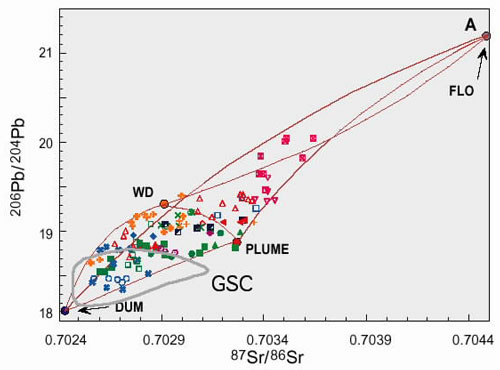 |
Some
Problems with the Plume Hypothesis for the Galápagos
Islands |
|
|
| |
Introduction
Many aspects of Galapagos geology may be inconsistent
with a plume origin. Most of the irregularities
have been attributed to the proximity of the plate
boundary, which results in abnormally hot upper mantle
material (because of upwelling), abnormally thin lithosphere,
and abnormal stresses, especially because of ridge-transform
intersections (e.g. Geist et al., 1988; White
et al., 1993; Kurz & Geist, 1999;
Harpp & White, 2001; Harpp &
Geist, 2002). We believe that a plume rooted
in the lower mantle best explains the major features
of the archipelago and related seamounts, but despite
that we also believe we are obligated to explore alternative
hypotheses.
|
1. Volcanic alignments
seem to indicate control by lithospheric stresses

Figure 1
Instead of forming a single or dual
line of volcanoes, the volcanoes are distributed in
two alignments that were first noted by Charles Darwin
(Figure 1). The lineaments have no relation to
either "absolute" plate motion (easterly red arrow)
or plate spreading (southerly red arrow). These
NE- and NW- oriented lineaments must be giant fractures
or weak spots in the lithosphere. Of course, lithospheric
fracturing and the presence of a deeply-rooted plume
are not exclusive, and in fact might be expected. |
2. Volcanism is not
strictly time-transgressive
 |
The line in Figure 2 indicates the predicted
island age, on the basis of the hotspot-reference
frame model of Gripp & Gordon (1990),
and assuming that the hotspot is currently at
the longitude of Fernandina. On the whole,
the exposed lavas are much younger than predicted
by the hotspot reference frame.
Figure 2
|
|
3. The "hotspot" magmas aren't
very hot
Figure 3 shows our best estimates of the temperatures
of the erupted magmas directly over the hotspot.
These temperatures are 50-100°C cooler than
those of Hawaiian basalts. This could be due
to cooling during ascent through the lithosphere
or simply that the magmas never started out
all that hot.
|

Figure 3 |
|
4. Isotopic evidence
is equivocal

Figure 4
Many of the Galápagos Island
lavas are isotopically indistinguishable from those
of the Galapagos Spreading Center. Those island lavas
that are more extreme can be explained as low-degree
melts of heterogeneities in the upper mantle with compositions
similar to FLO, WD, and PLUME. FLO, WD, and PLUME are
compositional endmembers, as identified by principal
component analysis of isotopic and trace element data
on all Galapagos Island and seamount data (Harpp
& White, 2001). |
5. The aseismic
ridges don't have hotspot-like subsidence trends

Figure 5
The Nazca and Carnegie ridges do not
have subsidence patterns that would result from
normal contraction of reheated lithosphere. Volcanism
at Cocos Island, which supposedly passed the hotspot
at 6 Ma, is dated at only 2 Ma. The Cocos Ridge
is effectively flat with some anomalous bumps on it,
consistent with early growth along most of its length
and some anomalous younger events. |
Conclusion
Although there are features of the
Galapagos archipelago that may be inconsistent with
simple plume theory, most of them can be explained by
perturbations attributable to the proximity of the Galapagos
Spreading Center. No-one, including us, has proposed
a viable, testable alternative hypothesis that is consistent
with the observations presented here. |
| ... and
for the alternative view ... |
References
-
Geist, D. J., White, W. M. & McBirney, A. R. (1988). Plume
asthenosphere mixing beneath the Galápagos
Archipeligo. Nature, 333, 657-660.
-
Gripp, A.E. & Gordon, R.G., (1990), Current plate velocities
relative to the hotspots incorporating the NUVEL-1
global plate motion model, Geophys. Res. Lett.,
17, 1109-1112.
-
Harpp, K. S., White, W. M. (2001). Tracing a mantle plume;
isotopic and trace element variations of Galápagos
seamounts. Geochemistry, Geophysics, Geosystems,2,
46. (paper number 2000GC000137).
-
Harpp,
K., Geist, D., Wolf-Darwin lineament and plume-ridge
interaction in northern Galápagos, Geochemistry,
Geophysics, Geosystems, 3,
DOI number 1029/2002GC000370, 2002.
-
Kurz,
M.D. & Geist, D. (1999), Dynamics and evolution
of the Galapagos hotspot from helium isotope
geochemistry, Geochim Cosmochim Acta,63, 4139-4156.
-
White,
W.M., McBirney, A.R. & Duncan, R.A. (1993).
Petrology and geochemistry of the Galápagos
Islands: portrait of a pathological mantle plume.
J. Geophys. Res.,
98, 19,533-19,564.
|
|
|
